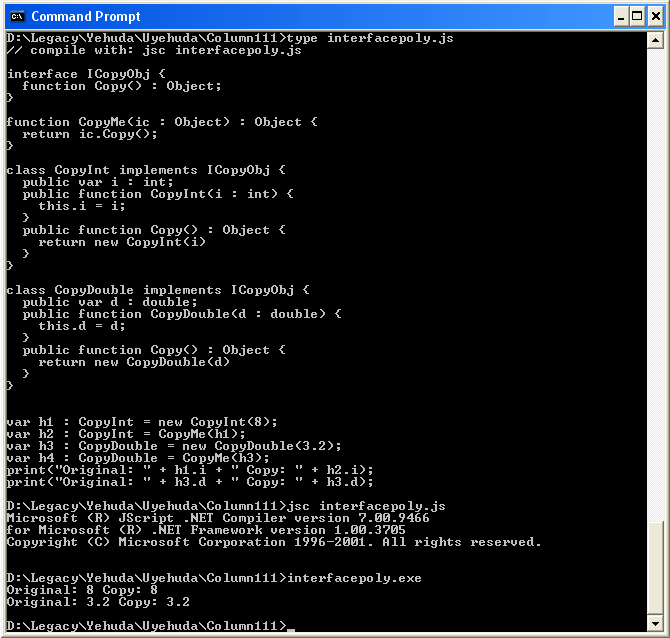July 1, 2002 - Calling a Polymorphic Utility
 |
July 1, 2002 Calling a Polymorphic Utility Tips: July 2002
Yehuda Shiran, Ph.D.
|
h1 is created by the CopyInt() constructor. The variable h2 is created by copying h1 with the polymorphic utility CopyMe(). The variable h3 is created by the CopyDouble() constructor, and is copied to h4 with the polymorphic utility CopyMe(). The utility CopyMe() is polymorphic because it operates on both integer and double values. The programmer who calls CopyMe() does not care how it is implemented. It is hidden from him. He or she can call CopyMe() with any object type. We print all variables at the end. Here is the code listing:
// compile with: jsc interfacepoly.js
interface ICopyObj {
function Copy() : Object;
}
function CopyMe(ic : Object) : Object {
return ic.Copy();
}
class CopyInt implements ICopyObj {
public var i : int;
public function CopyInt(i : int) {
this.i = i;
}
public function Copy() : Object {
return new CopyInt(i)
}
}
class CopyDouble implements ICopyObj {
public var d : double;
public function CopyDouble(d : double) {
this.d = d;
}
public function Copy() : Object {
return new CopyDouble(d)
}
}
var h1 : CopyInt = new CopyInt(8);
var h2 : CopyInt = CopyMe(h1);
var h3 : CopyDouble = new CopyDouble(3.2);
var h4 : CopyDouble = CopyMe(h3);
print("Original: " + h1.i + " Copy: " + h2.i);
print("Original: " + h3.d + " Copy: " + h3.d);interfacepoly.js), the jsc compiler's log messages, and the output of interfacepoly.exe:



 Find a programming school near you
Find a programming school near you